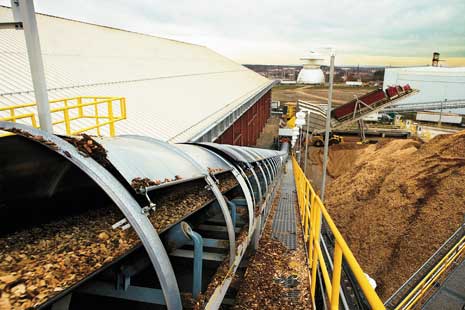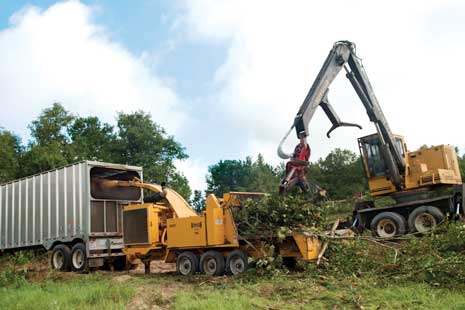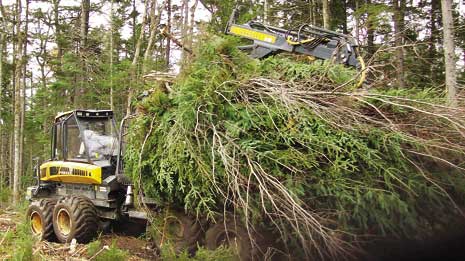Previous Page: [1]
Pulp/Paper Challenges
Overall, pulp and paper output decreased 7% between 1999 and 2005, according to USFS data, but in the South, where it is concentrated across some 83 mills, capacity dropped by 12% between 1998 and the middle of last year, according to the newsletter International Woodfiber Report (IWR). Mill and machine shuts since last fall have idled even more capacity, at least temporarily. (Some analysts contend that certain temporary plant/machine shuts will be permanent.) The troubled sector for years has struggled with higher costs for energy, raw materials and labor; high debt burden; increased imports; declining domestic paper consumption; industry consolidation; plant/machine obsolescence and global competition. Imports, along with energy and raw material costs, have retreated in recent months, but major challenges persist.
All this, combined with the pulp and paper industry’s dramatic waste paper recycling ramp-up over time, has resulted in a corresponding spotty falloff in raw material demand. Compared with the 1994 peak of 257 million tons, USFS report 637 pegged pulpwood consumption at just over 230 million tons in 2005. Pulpwood demand continues to weaken overall. IWR Editor Chris Lyddan estimates pulpwood consumption at 223 million tons in 2008 and suggests it could slip to below 200 million tons in 2009—this would be the lowest since 1982—before gradually rebounding.
Few contest the view that the U.S. pulp and paper industry is largely a mature, low profit (or no profit) undertaking. The last greenfield mill was built in 1991, according to Timber Mart-South. Maintenance costs are very high for aging facilities and many of these are not very efficient.
In recent years, under pressure from Wall Street to improve their balance sheets and overall attractiveness to investors, most publicly traded forest products and paper companies maneuvered to reinvent themselves. An industry that for decades had become quite integrated went the other way, shedding or closing non-core divisions, subsidiaries and certain types of plants, and selling timberlands. A few recast themselves as Real Estate Investment Trusts, toning down manufacturing and turning up timberland acquisition and management.
In selling timberland, companies paid down debt, trimmed related management costs, and realized property and severance tax relief, but not without consequences. Companies found themselves 100% reliant on the vagaries of the timber market, even with the security of long-term supply agreements that often accompanied land transactions.
rocurement organizations no longer enjoyed the luxury of applying book values or arbitrary prices to corporate-controlled stumpage and were without convenient “standing inventory” reserves that it could tap during times of supply crises.

This New Hampshire power plant once burned coal but now uses 450,000 tons of chips annually.
Yet, despite this development, and other supply issues, including high 2008 transportation costs and accelerated logger attrition, the South’s pulp and paper industry continues to benefit from comparatively low pulpwood stumpage prices, which translate into comparatively low wood fiber prices at the mill gate. According to Timber Mart-South, the average south-wide price for softwood pulpwood stumpage remained well below $10 per ton from the fourth quarter of 1998 through the end of last year, and from 2000 through 2006 the regional average was in the $7 per ton range. Only in late 2008 did prices briefly rival those prevailing in 1998-1999. Average hardwood pulpwood stumpage prices across the region during the period were generally 15-20% lower than pine. In all regions, both types of pulpwood stumpage prices have slumped significantly this year.
New Market
It’s against this backdrop that the young wood-to-energy market is taking root. Across North America, some 100 new projects have been announced since late 2006 and others are being planned. A few plants have started up and some are under construction. Also, in the background are dozens of other smaller, mostly unannounced projects ongoing at federal, state and local levels. Of the 100, at least two-thirds are in the U.S.; almost one-third in the South.
However, this young market is not so young in New England, where a dozen or so wood-fired power plants were built during the Carter presidency, only to fade with the 1980s oil glut. In recent years most of those plants were revitalized, often under new ownership, and others, including a few pellet plants, have sprung up. Also, the odd coal-fired power plant in the region has converted to wood, at least partially. Today there are 16 wood energy plants in Maine and New Hampshire alone with a combined annual appetite of about 8.5 million tons. Two more are in the planning stage and a Maine paper company proposes to bring a wood gasification facility on line. (Eight pulp-paper mills in the two states burn about 5.5 million tons of biomass per year in their on-site co-gen plants.)
Don White, President of the Prentiss & Carlisle land management and wood supply entities headquartered in Bangor, Me., reports that biomass demand was good throughout 2008 and continued into this year, but cautions that it may begin to slow as the recession knifes into industrial electricity demand.
Early on, some observers predicted that not all announced U.S. bioenergy plants would be built. Given the financial trepidation of late, those predictions may have even more merit. However, that is not the impression of John Colquitt, once a principal in Fram Fuels LLC, a Swedish-owned pellet plant in Baxley, Ga. and now a wood bioenergy feedstock consultant based in Savannah. “There seems to be continuing interest, particularly among Europeans, in exploring wood-using energy plant sites along the south Atlantic seaboard,” he said recently, predicting (50 to 100% probability) that another six pellet plants will be announced in the South in the next two years. “An emerging concept is a combination co-gen facility combined with a pellet plant. I don’t know how it will play out but financing doesn’t seem to be an issue, at least for now.”
That could change, however, and domestic investor interest in renewable energy facilities may have waned somewhat, given harsh economic realities and the recent freefall, however short-lived, of fossil fuel prices. Still, if nothing else, the drive toward developing alternative energy is being propelled by the green movement, political will and legislation at both federal and state levels. Energy diversity and independence are high priorities in Washington and are important to national security. So the potential for deriving energy from wood, directly or indirectly, is huge, and apparently many believe its time has come.
Supply Chain Impact
If the budding wood energy industry does develop as many anticipate, how much wood fiber will it require? What impact will it have on the existing wood supply chain? Because the target is constantly moving and the global economy is on its knees, at least for now, the answer is anything but clear.
Should multiple factors converge in the short-term, leading to a bioenergy boom over the next 10-20 years, the wood fiber requirement across North America could be huge, perhaps topping 50 million tons per year by late 2015, according to information published by RISI, Inc., a leading global forest products information provider. Speaking at the Forest Resources Assn.’s annual meeting in March, RISI’s Rocky Goodnow hinted that just as in-woods chipping capacity ramped up in the last two years to help make up for the sawmill-to-pulp mill chip shortfall, it could accelerate again to help meet wood energy plant feedstock demands.

Texas logger Brad Hassig now sends biomass to pulp-paper mills; awaits power plant markets in the state.
Pete Stewart, founder, president and CEO of Forest2Market, a Charlotte, NC based forest industry information and analytical group, recently wrote that even though collective bioenergy plant announcements in the South alone equal a projected fiber demand of 30 million tons per year by 2015, his group expects that only about half of announced capacity will make it into full production. Even so, he concluded, “…the resulting disruptions to the wood fiber supply chain will be significant.” In the same article, Stewart described pellet manufacturing as “the most established and stable of these (energy) markets and indicated that in North America wood fiber consumption by pellet manufacturers “could quickly become 20 million tons.”
Wood Resource Quarterly (WRQ) of Seattle reported that global pellet production was close to 10 million tons in 2008 (from virtually nothing in 1993) and is on track to double in the next five years. The largest market now is Europe. Canada is the world leader in pellet exports, but the WRQ report hinted that the U.S. may eventually become Canada’s largest market, forcing European consumers to look elsewhere. In fact, they may be looking already.
Most existing pellet, power-heat and ethanol or biorefinery (mostly pilot) plants today primarily use wood residues—sawdust, bark, demolition material, tree trimmings, sawmill chips, logging leftovers, etc.—but not much roundwood. Plans for some new plants were likely advanced on the assumption that the wood feedstock would be free or very low-cost. That may be true in a few isolated instances but not generally. Moreover, in numerous instances, planners had not given much thought to supply, recovery or transportation. And they did not always consider existing wood-using plants in selecting potential plant sites. Once reality sunk in, some plans no doubt were reconsidered and possibly shelved.

In Maine, Ponsse forwarder collects logging slash and transports it to landing to be chipped.
Continue Reading: [3]